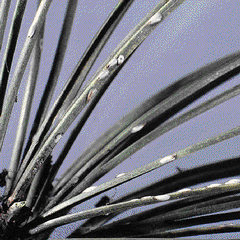The Ortho Home Gardener's Problem Solver
Pinus: Pine Needle Scale
 Problem
Problem
Needles are covered with clusters of somewhat flattened, white scaly bumps. When heavily infested, the foliage may appear completely white. The bumps can be scraped or picked off; the undersides are usually soft. Needles turn brown and eventually drop. Repeated severe infestations may kill young trees or weaken older trees.
Analysis
(Chionaspis pinifoliae)
These scale insects may seriously damage pine and spruce trees and may infest fir, hemlock, and cedar. The scales survive the winter on the pine needles as eggs beneath the dead mother scales. The eggs hatch in late spring and the young scales, called crawlers, move to new green needles. The small (1/10 inch), soft-bodied young feed by inserting their mouthparts and sucking sap from the plant. The legs atrophy and a crusty white shell develops over the body. The mature female scales lay their eggs underneath their shell in July. This next generation feeds throughout late summer and matures in fall. Females of this generation lay the overwintering eggs.
Solution
Spray young trees with an insecticide containing acephate, carbaryl, or malathion in late spring when the young are active. The following early spring, before new growth begins and when the danger of frost is past, spray with a pesticide containing lime sulfur to kill the overwintering eggs. Inspect ornamental pines twice a year for evidence of infestation. Older trees seldom require controls.
Copyright©1997. Books That Work.
Copyright©1982, 1993, 1997. Monsanto Company.
Visit Books That Work at http://www.btw.com
